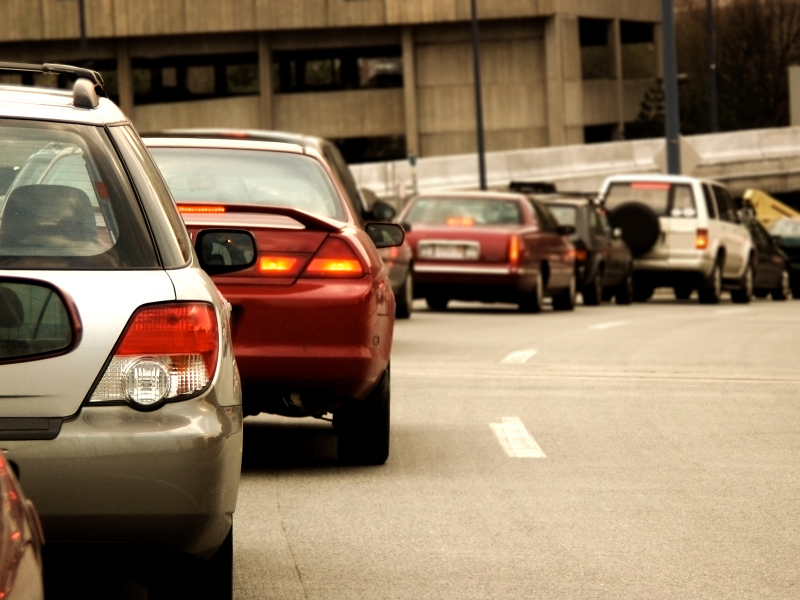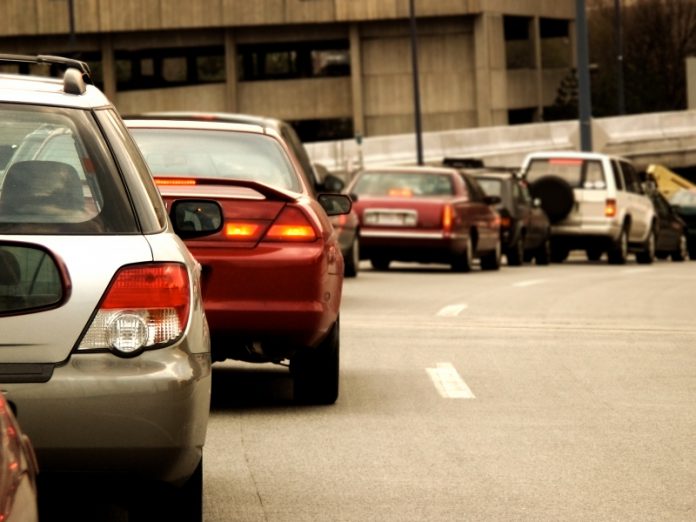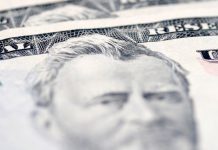
At NerdWallet, we adhere to strict standards of editorial integrity that will help you decide with full confidence. Many or all of the products featured here are from our partners. Here’s how we earn money.
Add another item to Boston’s listing of historic features: miserable driving of historic proportions. Boston tops the rankings from the worst cities for car drivers in NerdWallet’s latest study.
At a peek, the worst cities for car drivers
| Rank | Location | Overall score |
|---|---|---|
| 1 | Boston, Massachusetts | 38.22 |
| 2 | Washington, D.C. | 38.24 |
| 3 | Los Angeles, California | 41.79 |
| 4 | Miami, Florida | 45.15 |
| 5 | Chicago, Illinois | 45.20 |
| 6 | San Francisco, California | 45.42 |
| 7 | Philadelphia, Pennsylvania | 45.88 |
| 8 | Seattle, Washington | 48.00 |
| 9 | Detroit, Michigan | 48.61 |
| 10 | New York City, New York | 48.64 |
?
Traffic congestion and delays are everyday trouble for city drivers. The Texas A&M Transportation Institute discovered that the average U.S. driver spends 33 hours in traffic delays every year, but drivers in big cities often idle away more time. Rainy weather may also make delays exponentially worse.
Poor weather conditions, lack of parking along with a higher likelihood of an accident also bring about a crummy driving environment.
In accessory for driving conditions, car ownership costs can differ significantly based on location. Car insurance premiums are a pain point for residents in highly populated areas. They face higher rates because crowded areas typically have more accidents, car thefts and other claims.
To find the worst cities for car drivers, NerdWallet analyzed driving conditions, time spent driving and insurance costs.
Compare quotes side-by-side using NerdWallet’s auto insurance tool
NerdWallet’s analysis
NerdWallet analyzed these seven factors to determine the worst cities for car drivers:
- How bad are delays? We examined the average annual hours of delay each year for each location for 30% of the score.
- How congested is it during peak trips??To provide a concept of how much congestion you may experience, we checked out the proportion of the population that drives to work during peak commute hours. This is 10% of the score.
- How’s the elements? Poor weather conditions could make driving dangerous. We looked at the number of days with precipitation for 10% of the score.
- Is parking available? Once you are making it to your destination, lack of parking may cause major headaches. We checked out the amount of parking lots and garages per 1,000 commuter vehicles. This really is 10% of our score.
- How much does auto insurance cost annually? Insurance is expensive and premiums can vary depending on where you reside. We found average annual car insurance premiums for each city. Crime, for example car theft, and population density can affect auto insurance premiums. This really is 10% of the score.
- How expensive is gas? We checked out average gas prices in every place for 10% from the score.
- Is there a greater opportunity for an accident? Accidents will not be free and inconvenient. We checked out the relative probability of any sort of accident for every city compared with?the national average. This really is 20% from the score.
10 worst cities for car drivers?
1. Boston, Massachusetts
Boston is the worst spot for car drivers, according to NerdWallet’s study. Among all from the cities NerdWallet surveyed, drivers in Boston have the greatest likelihood of an accident. And with almost an additional 10 days of snow and rain in contrast to?the national average, driving conditions in Boston can easily?go from bad to worse. Major roadways are often congested and drivers can get 53 hours of traffic delays each year – 20 hours greater than the nation’s average. In addition, parking spaces may be limited, with only 1.36 parking garages and lots for each 1,000 commuter cars. It’s no wonder that one-third of commuters use public transit, which includes the MBTA subway and buses.
2. Washington, D.C.
It’s a waiting game in the nation’s capital. In contrast to other major cities, Washington, D.C., drivers waste probably the most time in delays: 67 hours each year. Additionally, drivers pay a hefty sum for car insurance premiums at $1,390.88 – nearly $300 more than drivers within the remaining nation. Tourists don’t help matters. They’re often lost on the city’s confusing traffic circles and one-way streets. Those who wish to avoid driving may take the Metro, the regional subway system.
3. Los Angeles, California
Los Angeles is better than other California cities of the worst driving conditions. Drivers within the Los Angeles area endure typically 61 hours of delays each year, and 55.1% of commuters travel during peak hours. Many Los Angeles interstates, which include the 110 and the 405, are notorious for bumper-to-bumper traffic. Additionally, Los Angeles gas costs are expensive at $4.01 a gallon, which is 57 cents higher than the national average.
4. Miami, Florida
Miami is beloved for its tropical weather, sandy beaches and Cuban vibe. However the congested roads can dampen spirits. Along with major traffic during prime time, car owners pay typically $1,750.10 for auto insurance annually, 59% a lot more than the average U.S. driver. Every year, Miami drivers spend an extra 47 hours a year behind the wheel, 14 hours more than the national average. Even though Miami residents mostly rely on their vehicles to obtain around, public transit is an option. Miami-Dade Transit offers bus lines and railways that make 353,000 trips each weekday.
5. Chicago, Illinois
Along with treacherous climate conditions for a substantial part of?the entire year, Chicago has one of the worst driving environments in america. Drivers face typically 51 hours of delays every year, and over half of commuters travel during peak hours. Parking could be sparse in Chicago, with only 0.77 parking lots or garages for 1,000 commuter vehicles. Instead of driving, you are able to rent a bike with DIVVY, Chicago’s bike-sharing system. Currently, there are approximately 3,000 bikes at 300 stations.
6. San Francisco, California
Like their counterparts in Los Angeles, San Francisco drivers waste a significant amount of time in traffic: 61 hours each year. During peak hours, nearly 53% of the population can be found commuting. In addition, according to the National Insurance Crime Bureau, the San Francisco-Oakland-Hayward area ranked No. 4 in the nation for auto theft in 2013. To focus on different commuting needs, companies such as Scoot offer transportation options. Scoot rents out electric scooters in San Francisco, allowing locals to travel the city in a more eco-friendly fashion.
7. Philadelphia, Pennsylvania
Philadelphia’s driving conditions could leave your face ringing. The city saw 113 times of precipitation in 2012, and drivers are 61.2% more prone to enter into an accident than drivers in other U.S. cities. Typically, drivers can get to pay for $1,278.20 for auto insurance, over $170 a lot more than the national average. Gas prices are costly too at 16 cents above the average U.S. cost per gallon. If you want to declare your independence from driving, Philadelphia’s riding on the bus agency, SEPTA, supplies a wide selection of transportation options, ranging from buses and trolleys to subways.
8. Seattle, Washington
Seattle’s frequent rainy weather results in a dangerous driving environment with slick roads and poor visibility. Based on the National Oceanic and Atmospheric Administration, Seattle had 150 days of rain in 2012 – 40 days a lot more than the national average. Besides the weather, drivers face Two days of traffic delays each year or nearly 46% more than the nation’s average.
9. Detroit, Michigan
While the Motor City makes a lot of cars, there’s nowhere to fit them. Detroit has got the lowest parking availability on our top 10 list: For every 1,000 commuter cars, you will find 0.49 parking lots or garages. Then, there are the horrendous insurance costs. Detroit drivers pay an astonishing average of $4,924.99 each year for car insurance – over 347% of the items the average U.S. motorist pays. In 2012, Detroit had 11,500 automobile thefts, based on data from the FBI. Crime and car theft can boost insurance premiums for residents.
10. Nyc, New York
New York City is the nation’s most populated city and its streets bear the brunt. Car owners spend $1,614.71 annually on car insurance, $500 above the national average. Additionally, drivers in the The big apple face 59 hours of delays each year, that is likely why Nyc has a strong public transit culture. The New York City Transit Authority, which includes the subways, is the largest heavy rail transit system in the nation. New York City also has bike-sharing programs available, including Citi Bike, where individuals can rent bikes to get around.
?
Worst cities for car drivers?
| Rank | Location | Average annual hours of traffic delays | Percent of peak-period commuters per population | Days of precipitation | Parking garages and lots per 1,000 commuter vehicles | Average annual car insurance premium | Average gas price | Accident likelihood compared with?the national average | Overall score |
|---|---|---|---|---|---|---|---|---|---|
| 1 | Boston, MA | 53 | 50.9% | 120 | 1.36 | $1,174.50 | $3.60 | 129.9% | 38.22 |
| 2 | Washington, DC | 67 | 50.8% | 111 | 3.29 | $1,390.88 | $3.57 | 97.3% | 38.24 |
| 3 | Los Angeles, CA | 61 | 55.1% | 32 | 0.70 | $1,175.61 | $4.01 | 52.8% | 41.79 |
| 4 | Miami, FL | 47 | 57.7% | 126 | 0.76 | $1,750.10 | $3.63 | 49.9% | 45.15 |
| 5 | Chicago, IL | 51 | 54.7% | 119 | 0.77 | $1,243.52 | $4.16 | 22.0% | 45.20 |
| 6 | San Francisco, CA | 61 | 52.8% | 61 | 1.43 | $1,013.90 | $3.73 | 55.6% | 45.42 |
| 7 | Philadelphia, PA | 48 | 56.1% | 113 | 0.56 | $1,278.20 | $3.60 | 61.2% | 45.88 |
| 8 | Seattle, WA | 48 | 55.9% | 150 | 1.52 | $1,016.86 | $3.78 | 36.0% | 48.00 |
| 9 | Detroit, MI | 40 | 56.6% | 128 | 0.49 | $4,924.99 | $3.52 | 10.6% | 48.61 |
| 10 | New York, NY | 59 | 47.8% | 116 | 1.59 | $1,614.71 | $3.72 | 28.8% | 48.64 |
| 11 | Houston, TX | 52 | 59.1% | 98 | 0.31 | $1,209.82 | $3.29 | 29.4% | 48.95 |
| 12 | Baltimore, MD | 41 | 57.0% | 108 | 0.69 | $1,250.79 | $3.44 | 84.9% | 49.01 |
| 13 | Atlanta, GA | 51 | 54.4% | 107 | 1.38 | $1,021.46 | $3.44 | 39.4% | 52.42 |
| 14 | Honolulu, HI | 45 | 55.9% | 88 | 1.45 | $948.38 | $4.21 | 22.0% | 52.75 |
| 15 | Portland, OR | 44 | 52.3% | 123 | 0.31 | $1,251.04 | $3.60 | 37.2% | 53.08 |
| 16 | Providence, RI | 30 | 55.4% | 119 | 0.56 | $2,031.28 | $3.60 | 85.1% | 53.12 |
| 17 | Dallas, TX | 45 | 60.1% | 71 | 0.36 | $1,157.10 | $3.36 | 36.0% | 53.80 |
| 18 | Orlando, FL | 45 | 57.0% | 110 | 0.37 | $1,218.03 | $3.42 | 16.7% | 54.90 |
| 19 | Denver, CO | 45 | 62.9% | 82 | 0.76 | $1,042.30 | $3.46 | 7.2% | 55.41 |
| 20 | Cincinnati, OH | 37 | 57.4% | 125 | 0.75 | $744.90 | $3.61 | 35.8% | 56.70 |
| 21 | Nashville, TN | 47 | 57.0% | 113 | 0.41 | $928.63 | $3.33 | 2.7% | 56.77 |
| 22 | Austin, TX | 44 | 57.0% | 77 | 0.22 | $1,061.18 | $3.33 | 30.3% | 57.01 |
| 23 | Tampa, FL | 38 | 57.0% | 99 | 0.41 | $1,502.84 | $3.40 | 30.5% | 58.24 |
| 24 | Indianapolis, IN | 41 | 57.0% | 120 | 0.19 | $982.46 | $3.45 | 5.2% | 58.36 |
| 25 | Louisville, KY | 35 | 57.0% | 119 | 0.21 | $1,783.94 | $3.69 | 2.2% | 58.90 |
?
Methodology
NerdWallet examined some of the nation’s most populous cities and found the 25 worst cities for drivers by analyzing the next factors:
- Annual hours of delay: We used traffic congestion data from Texas A&M Transportation Institute. More time of delay led to a lesser overall score.
- Peak-period commuters per population: We used traffic congestion data from Texas A&M Transportation Institute. A greater number of peak-period commuters per population resulted in a lower score.
- Days of precipitation: We used data from the National Oceanic and Atmospheric Administration and located times of precipitation in 2012. More days of precipitation resulted in a lesser score.
- Parking garages and lots per 1,000 commuter vehicles: We used data from the U.S. Census Bureau’s American Community Survey. More parking garages and plenty per 1,000 commuter vehicles resulted in a higher score.
- Average annual auto insurance premium: We used data from NerdWallet’s auto insurance comparison tool. To look for the average insurance premium increases, we used quotes for eight driver profiles: 27-year-old single men and women and 40-year-old married women and men each driving a Toyota Camry and a Ford Escape. For each driver profile, we used every city’s three cheapest auto insurance quotes (to reflect consumer behavior) and also to determine our overall average. A more expensive insurance premium resulted in a lesser score.
- Average gas prices: We used 2014 data from the Council for Community and Economic Research to locate average gas prices in every location. Higher gas prices resulted in a lower score.
- Accident likelihood in contrast to that of the nation’s average: We used data from Allstate’s America’s Best Drivers Report. A lesser percentage led to a higher score.
[Car insurance premium data are from NerdWallet’s car insurance comparison tool.]
Image via iStock.














